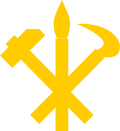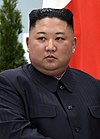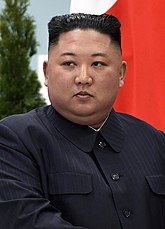General Secretary of the Workers' Party of Korea
| General Secretary of the Workers' Party of Korea 조선로동당 총비서 | |
|---|---|
 Emblem of the WPK Chairman | |
 Emblem of the Workers' Party of Korea | |
| Workers' Party of Korea | |
| Style | Comrade (Korean: 동지; Hanja: 同志) |
| Type | Party leader Supreme leader |
| Residence | Forbidden City |
| Seat | Pyongyang |
| Nominator | WPK Congress |
| Appointer | WPK Congress |
| Term length | No fixed term |
| Constituting instrument | WPK Charter |
| Inaugural holder | Kim Tu-bong |
| Formation | 28 August 1946 |
| Deputy | Secretariat |
| General Secretary of the Workers' Party of Korea | |
| Hangul | 조선로동당 총비서 |
|---|---|
| Hanja | |
| Revised Romanization | Joseon Rodongdang Chongbiseo |
| McCune–Reischauer | Chosŏn Rodongdang Ch'ongbisŏ |
 |
|---|
|
The General Secretary of the Workers’ Party of Korea (Korean: 조선로동당 총비서) is the leader of the Workers' Party of Korea (WPK), the ruling party in North Korea and typically the supreme leader of North Korea. Party rules stipulate that the General Secretary is elected by the party congress. The party leader can also be removed and elected by the party conference and by the Central Committee. The General Secretary is ex officio of the Chairman of the Central Military Commission of the Workers’ Party of Korea and leads the work of the Secretariat.[1][2] Additionally, the General Secretary is by right of office member of the WPK Presidium, the WPK Politburo and the WPK Central Committee.
The office traces its lineage back to the reestablishment of the Communist Party of Korea (CPK) on 14 September 1945 when Pak Hon-yong was elected Chairman of the CPK Central Committee.[3] Later on 13 October 1945 the CPK established an internal North Korean Branch Bureau (NKBB) and nominated as branch secretary.[4] Hyon Chun-hyok was assassinated on 28 September 1945 and Kim Yong-bom was elected as branch secretary in his place.[5][6] On 10 April 1946 the NKBB became independent of the CPK and changed its name to Communist Party of North Korea (CPNK).[5] Later that year, on 30 August, the CPNK merged with the New People's Party of Korea to establish the Workers' Party of North Korea (WPNK).[7] Kim Tu-bong was elected WPNK Chairman by the 1st WPNK Central Committee.[8] In the meantime the Workers' Party of South Korea was established through the merger of the Communist Party of South Korea, New People's Party of Korea and a faction of the People's Party of Korea on 24 November 1946.[9] The WPSK Central Committee elected Ho Hon as its party chairman.[10] On the merger of the WPNK with the Workers' Party of South Korea on 24 June, the 2nd Central Committee elected Kim Il-sung as Chairman of the WPK Central Committee.[11]
The offices of Chairman and Vice Chairman of the WPK Central Committee was abolished on 12 October 1966 and replaced with the offices of General Secretary and Secretary of the WPK Central Committee by a decision of the 14th Plenary Session of the 4th Central Committee.[12] Kim Il-sung was elected to the office, and remained in office until his death on 8 July 1994.[12][13] The post was left vacant for three years and then abolished and replaced by the office of General Secretary of the Workers' Party of Korea on 8 October 1997.[13] Kim Jong-il was elected to the office by a joint announcement of the 6th Central Committee and the 6th Central Military Commission.[13] Kim Jong-il remained in office until his death on 17 December 2011. Kim Jong-un was elected First Secretary of the Workers' Party of Korea on 11 April 2012, and his father Kim Jong-il was given the appellation "Eternal General Secretary of the Workers' Party of Korea".[14] On 9 May 2016, the 7th WPK Congress abolished the office of First Secretary and the Secretariat and replaced it with Chairman of the Workers' Party of Korea and the office of Vice Chairman of the WPK Central Committee.[15] A similar change took place at the 8th WPK Congress, where the offices of chairman and vice chairman was abolished and replaced by the General Secretary of the Workers' Party of Korea office and the Secretariat.[16]
Title history[]
| Title | Established | Abolished | Established by |
|---|---|---|---|
| Chairman of the Central Committee of the Communist Party of Korea 조선공산당 중앙위원회 위원장 |
14 September 1945 | 10 April 1946 | |
| First Secretary of the North Korean Branch Bureau of the Communist Party of Korea 조선공산당 북조선분국 비서 |
13 October 1945 | 10 April 1946 | |
| First Secretary of the Central Committee of the Communist Party of North Korea 북조선공산당 중앙위원회 위원장 |
10 April 1946 | 30 August 1946 | 5th Enlarged Plenary Session of the North Korean Branch Bureau's Executive Committee |
| Chairman of the Central Committee of the Communist Party of South Korea 남조선공산당 중앙위원회 위원장 |
10 April 1946 | 24 November 1946 | April Plenary Session of the Central Committee of the Communist Party of Korea |
| Chairman of the Central Committee of the Workers' Party of North Korea 북조선로동당 중앙위원회 위원장 |
30 August 1946 | 24 June 1949 | 1st Congress of the Workers' Party of North Korea |
| Chairman of the Central Committee of the Workers' Party of South Korea 남조선로동당 중앙위원회 위원장 |
24 November 1946 | 24 June 1949 | |
| Chairman of the Central Committee of the Workers' Party of Korea 조선로동당 중앙위원회 위원장 |
24 June 1949 | 12 October 1966 | 1st Joint Plenary Session of the 2nd Central Committee of the Workers' Party of Korea |
| General Secretary of the Central Committee of the Workers' Party of Korea 조선로동당 중앙위원회 총비서 |
12 October 1966 | 8 October 1997 | 14th Plenary Session of the 4th Central Committee of the Workers' Party of Korea |
| General Secretary of the Workers' Party of Korea 조선로동당 총비서 |
8 October 1997 | 11 April 2012 | Joint Communique of the 6th Central Committee and the 6th Central Military Commission |
| First Secretary of the Workers' Party of Korea 조선로동당 제1비서 |
11 April 2012 | 9 May 2016 | |
| Chairman of the Workers' Party of Korea 조선로동당 위원장 |
9 May 2016 | 10 January 2021 | 7th Congress of the Workers' Party of Korea |
| General Secretary of the Workers' Party of Korea 조선로동당 총비서 |
10 January 2021 | onwards | 8th Congress of the Workers' Party of Korea |
| References: [12][13][14][15][16][17] | |||
Predecessors (1945–49)[]
National[]
| № [note 1] |
Portrait | Name | Hangul | Birth | Death | Took office | Left office | Duration |
|---|---|---|---|---|---|---|---|---|
| 1 | 
|
Pak Hon-yong | 박헌영 | 1900 | 1955 | 14 September 1945 | 10 April 1946 | 208 days |
| References: [3] | ||||||||
In the North[]
| № [note 1] |
Portrait | Name | Hangul | Birth | Death | Took office | Left office | Duration |
|---|---|---|---|---|---|---|---|---|
| 1 | 
|
Kim Yong-bom | 김용범 | 1902 | 1947 | 13 October 1945 | 18 December 1945 | 66 days |
| 2 | 
|
Kim Il-sung | 김일성 | 1912 | 1994 | 18 December 1945 | 30 August 1946 | 255 days |
| 3 | 
|
Kim Tu-bong | 김두봉 | 1889 | 1958 | 31 August 1946 | 24 June 1949 | 2 years and 297 days |
| References: [18][19][20] | ||||||||
In the South[]
| № [note 1] |
Portrait | Name | Hangul | Birth | Death | Took office | Left office | Duration |
|---|---|---|---|---|---|---|---|---|
| 1 | 
|
Pak Hon-yong | 박헌영 | 1900 | 1955 | 10 April 1946 | 24 November 1946 | 228 days |
| 2 | 
|
Ho Hon | 허헌 | 1885 | 1951 | 24 November 1946 | 24 June 1949 | 2 years and 212 days |
| References: [10] | ||||||||
Leaders of the Workers' Party of Korea[]
By officeholders[]
| № [note 1] |
Portrait | Name | Hangul | Birth | Death | Took office | Left office | Duration |
|---|---|---|---|---|---|---|---|---|
| 1 | 
|
Kim Il-sung | 김일성 | 1912 | 1994 | 24 June 1949 | 8 July 1994 | 45 years and 14 days |
—
|
—
|
Vacant | —
|
—
|
—
|
8 July 1994 | 8 October 1997 | 3 years and 92 days |
| 2 | 
|
Kim Jong-il | 김정일 | 1941 | 2011 | 8 October 1997 | 17 December 2011 | 14 years and 70 days |
—
|
—
|
Vacant | —
|
—
|
—
|
17 December 2011 | 11 April 2012 | 116 days |
| 3 | 
|
Kim Jong-un | 김정은 | 1983 | —
|
11 April 2012 | Incumbent | 9 years and 157 days |
| References: [11][13][15] | ||||||||
By term[]
| Congress | Term | Start | End | Duration | Leader |
|---|---|---|---|---|---|
| 1st Congress | 1st Central Committee | 30 August 1946 | 30 March 1948 | 1 year and 213 days | Kim Tu-bong |
| 2nd Congress | 2nd Central Committee | 30 March 1948 | 29 April 1956 | 8 years and 30 days | Kim Tu-bong |
| Kim Il-sung | |||||
| 3rd Congress | 3rd Central Committee | 29 April 1956 | 18 September 1961 | 5 years and 142 days | Kim Il-sung |
| 4th Congress | 4th Central Committee | 18 September 1961 | 13 November 1970 | 9 years and 56 days | Kim Il-sung |
| 5th Congress | 5th Central Committee | 13 November 1970 | 14 October 1980 | 9 years and 336 days | Kim Il-sung |
| 6th Congress | 6th Central Committee | 14 October 1980 | 9 May 2016 | 35 years and 208 days | Kim Il-sung |
| Kim Jong-il | |||||
| Kim Jong-un | |||||
| 7th Congress | 7th Central Committee | 9 May 2016 | 10 January 2021 | 4 years and 246 days | Kim Jong-un |
| 8th Congress | 8th Central Committee | 10 January 2021 | Incumbent | 248 days | Kim Jong-un |
| References: [11][13][15][16][21][22][23][24][25] | |||||
See also[]
- Politburo of the Workers' Party of Korea
- Presidium of the Politburo of the Workers' Party of Korea
- Secretariat of the Workers' Party of Korea
Noter[]
- ^ Jump up to: a b c d These numbers are not official.
References[]
Footnotes[]
- ^ Madden, Michael (2 February 2012). "4th Party Conference To Convene in "mid-April"". North Korea Leadership Watch. Archived from the original on 12 February 2021. Retrieved 12 February 2021.
- ^ Madden, Michael. "Party Secretariat". North Korea Leadership Watch. Retrieved 13 February 2021.
- ^ Jump up to: a b Suh 1981, p. 281.
- ^ Suh 1981, pp. 279–80.
- ^ Jump up to: a b Suh 1981, p. 280.
- ^ Chong-sik 1963, p. 5.
- ^ Suh 1981, pp. 282–3.
- ^ Suh 1981, p. 283.
- ^ Suh 1981, p. 282.
- ^ Jump up to: a b Suh 1981, p. 318.
- ^ Jump up to: a b c Suh 1981, p. 321.
- ^ Jump up to: a b c Suh 1981, p. 328.
- ^ Jump up to: a b c d e f Gause 2011, p. 18.
- ^ Jump up to: a b Gause 2013, pp. 40–41.
- ^ Jump up to: a b c d Madden, Michael (20 May 2016). "Deciphering the 7th Party Congress: A Teaser for Greater Change?". 38 North. Archived from the original on 12 February 2021. Retrieved 12 February 2021.
- ^ Jump up to: a b c Ruediger, Frank (19 January 2021). "Key Results of The Eighth Party Congress in North Korea (Part 2 of 2)". 38 North. Archived from the original on 12 February 2021. Retrieved 12 February 2021.
- ^ Suh 1981, pp. 279–83.
- ^ Suh 1981, pp. 281–82.
- ^ Suh 1981, p. 316.
- ^ Suh 1981, p. 319.
- ^ Suh 1981, pp. 316–17.
- ^ Suh 1981, pp. 319–20.
- ^ Suh 1981, p. 322.
- ^ Suh 1981, p. 325.
- ^ Suh 1981, p. 332.
Bibliography[]
Books:
- Gause, Ken E. (2011). North Korea Under Kim Chong-il: Power, Politics, and Prospects for Change. ABC-CLIO. ISBN 978-0313381751.
- Gause, Ken (2013). "The Role and Influence of the Party Apparatus". In Park, Kyung-ae; Snyder, Scott (eds.). North Korea in Transition: Politics, Economy, and Society. Rowman & Littlefield. pp. 19–46. ISBN 978-1442218123.
- Suh, Dae-sook (1981). Korean Communism 1945–1980: A Reference Guide to the Political System (1st ed.). University Press of Hawaii. ISBN 0-8248-0740-5.
Journal articles:
- Chong-sik Lee (1963). "Politics in North Korea: Pre-Korean War Stage". The China Quarterly. Cambridge University Press on behalf of the School of Oriental and African Studies (14): 3–16. JSTOR 651339.
- Leaders of the Workers' Party of Korea and its predecessors
- Leaders of political parties in North Korea

